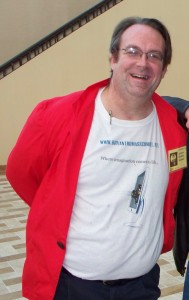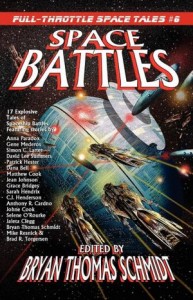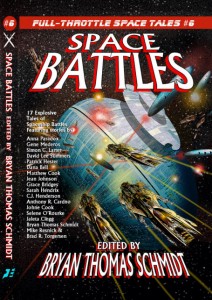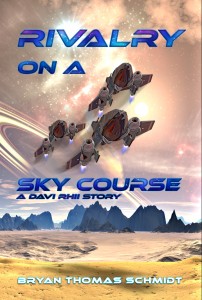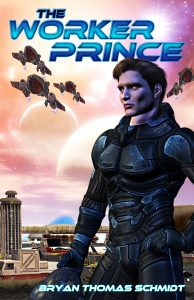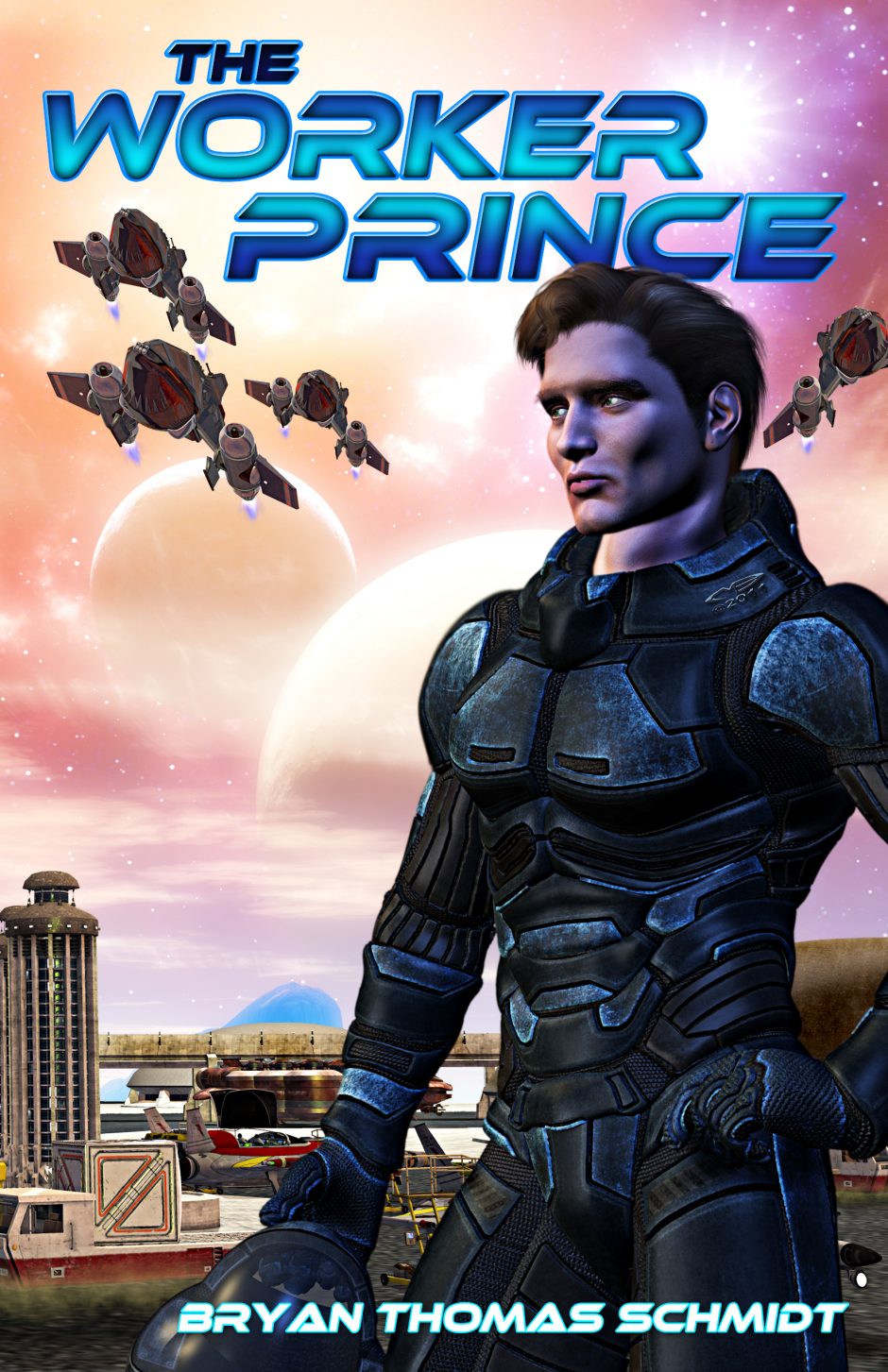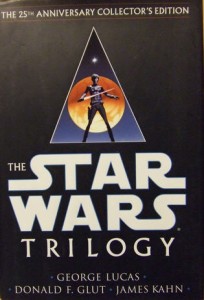 Despite being one of the founders and editors (i.e. Overlords) of Ray Gun Revival, “With All Due Respect, his Space Battles: Full Throttle Space Tales #6 story, is Johne Cook’s fiction in print. A technical writer by day and creative writer and editor at night, his interests include progressive rock, film noir, space opera, and racquetball. Johne is older than he looks but acts younger than he is. His short fiction has appeared in Deep Magic, The Sword Review, Wayfarer’s Journal, and Digital Dragon magazines. He can be found online at Facebook, on Twitter as @theskypirate and via Ray Gun Revival, where he hangs out often vaporizing someone’s puny planet for various arbitrary infractions. Married and newly a grandfather, fellow Space Battles author is no relation.
Despite being one of the founders and editors (i.e. Overlords) of Ray Gun Revival, “With All Due Respect, his Space Battles: Full Throttle Space Tales #6 story, is Johne Cook’s fiction in print. A technical writer by day and creative writer and editor at night, his interests include progressive rock, film noir, space opera, and racquetball. Johne is older than he looks but acts younger than he is. His short fiction has appeared in Deep Magic, The Sword Review, Wayfarer’s Journal, and Digital Dragon magazines. He can be found online at Facebook, on Twitter as @theskypirate and via Ray Gun Revival, where he hangs out often vaporizing someone’s puny planet for various arbitrary infractions. Married and newly a grandfather, fellow Space Battles author is no relation.
BTS: How did you find out about the Space Battles anthology and what made you decide to submit?
Johne Cook: I heard about the Space Battles anthology on Twitter in February a year ago and thought I might have something fun to add to the theme. Of course, rationalization is the second strongest human impulse.
BTS: This is your first anthology sale, correct? Tell us a little about “With All Due Respect.” What’s it about? Where’d this particular idea come from?
JC: It is my first anthology sale, and I’m delighted with the company I have fallen in with here.
This story features a character I’ve written about before, a space marine-turned-diplomat in homage to Keith Laumer’s “Retief” character. The Retief stories were funny and sharply satirical of governmental red tape while depicting the value of one good man whose primary gifts are common sense and personal initiative. In an era where we like to see how people change over the course of a story, I liked the idea of seeing how one good man could change the world around him over the course of a story.
I blame the situation in this story on my natural good-humored contrarianism. I grew up with Doc Smith and his endless technological escalation. For this story, I fell prey to a Whedonesque urge to tell a character-based story where the largest battle was really internal, man against his own nature, against his own fear. I wanted to see what would happen when one good man was stripped of everything and had nowhere left to hide. And honestly, I’m not as up on the latest trend in space armor and weaponry, so I thought I’d lean more on the man than his machines. In my vision, spacecraft of the near future aren’t that much different than what you might see today, no tractor beams, no artificial gravity onboard, no energy protective shields. In that environment, space battles become scarier because there’s no safety net, no formidable defenses to hide behind.
My original idea involved a sort of Trojan Horse, a diplomat going to meet with ravenous aliens and delivering the method of their destruction himself and leaving it attached to the hull of their ship or something. But along the way, I found surprising motivation for my alien antagonists and I discovered that the physics in space don’t work the way I’ve been trained to expect from every sci-fi movie ever. So that forced the first of many changes, ultimately leading to what I hope is a more interesting story.
BTS: How’d you get started as a writer?
JC: The seed was planted in the 4th Grade by my English teacher, Miss Kinane. It was the first time in my life that I ever felt I could do something effortlessly that others considered difficult and the curse of my daydreaming suddenly became a virtue. It was like discovering a superpower I was previously completely unaware of.
BTS: Where’d your love of SF come from?
JC: If writing was my new super ability, my dad’s phenomenal SF/F paperback library was my spice, my Melange, fueling that super power and stoking a fiery desire to see where it could take me.
BTS: Do you have plans to do any more with this universe?
JC: I’ve written two other stories with this character, Random Tenerife, entitled “Blessed Are the Peacemakers” and “Blessed Are The Persecuted.” I can imagine a series called something like “The Tenerife Beatitudes,” giving a SFnal treatment to all eight. As a person of faith, I was distressed that there wasn’t more SF I could embrace, and as a SF fan, I was distressed with the quality of the fiction passing itself off as being from the worldview I embrace. The thing is, I don’t care for preachy fiction. If I want answers from my reading, I’ll read non-fiction. I think the best Art asks questions without necessarily giving you the answer. This is where SF and my worldview can bring the greatest synergy.
BTS: You are a founder and editor of Ray Gun Revival magazine. Tell us about how that got started and what you do.
JC: RGR was spawned in 2006 in a surge of pure Browncoat passion when they took the sky from us. L. S. King and Paul Christian Glenn and I were so in love with space opera in general and Firefly in particular that we wanted to keep that space opera vibe going and started the magazine as a way to share that love with a new generation of readers and writers. It was also a testament to blissful ignorance of how much work it takes to cultivate such stories in an era where Cyberpunk (and later Steampunk) reigned supreme. Furthermore, it revealed a fundamental misunderstanding of one of the primary virtues of space opera, where bigger is usually better and we were looking for short stories. Fortunately, we didn’t know that we couldn’t make it cultivating and nurturing and growing a new generation of space opera and golden age sci-fi readers and writers. This summer, we celebrate the start of our seventh year of blissful ignorance and genre fun.
BTS: What other projects do you have in the works that we can look forward to?
JC: I’m two-thirds of the way through a swashbuckling adventure space opera novel called The Adventures of the Sky Pirate, and have a number of genre mash-up short stories in the works.
Here’s an excerpt from Johne’s Space Battles: Full Throttle Space Tales #6 story, “With All Due Respect”:
With All Due Respect
Johne Cook
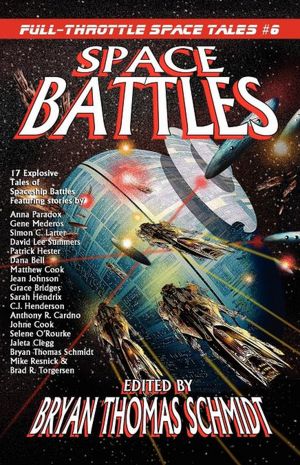 The first attack came shortly after they exited the jumpgate outside of Aldebaran.
The first attack came shortly after they exited the jumpgate outside of Aldebaran.
Random Tenerife was startled awake by a blaring klaxon. He heard the muted sound of a code being entered from the other side of the steel hatch. The interior bolt on his door unlocked. A red-haired stripling wearing spacer fatigues pushed the hatch open and poked his head in. “Mr. Ambassador?”
“Just ‘Tenerife,’” he corrected. Tenerife ran a hand over his face and rubbed away the sleep.
“I’m Ensign Salter, but everyone calls me ‘Salty.’ You should come with me.”
“What is the klaxon for?” Tenerife asked.
“It’s not for me to say,” Salty said.
“Very well.” Tenerife loosened the straps that kept him in his bunk and pushed off. As he floated over to the hatch, he saw two crewmen slide past pulling themselves hand-over-hand toward the cockpit in the zero gravity of the courier ship’s central corridor. He and Salty followed.
Three men were already floating in the small common area outside
the cockpit-proper. The man in uniform sitting in the elevated command
chair behind the pilot looked up at Salty and frowned. “Did you bring
the prisoner?”
The spacers parted and revealed Tenerife in back of the group.
“Captain,” he said.
“Salty, since you’re here, you may as well introduce everyone.”
“You know Captain Bolivar—he shares piloting and astrogation
duties with First Officer Ollie Wu. Abe Sigorda oversees the port cargo
hold, and Abe Fungee oversees the starboard cargo hold. They also
share some engineering expertise and help maintain the Kikayon, ergo
Portside Abe and Starboard Abe.”
Tenerife smiled.
“The only one missing is Chief Engineer Scott Magoro. He’s back
in the engine room.”
“Greetings,” Tenerife said.
“So, what’s going on with the klaxon?” Salty asked.
Mr. Wu spoke over his shoulder while scanning a display in front
of him. “That was a munitions-based proximity alarm,” said Mr. Wu.
“The interloper fired a dumb missile across our bow.”
Tenerife noted a collective shiver go through the tiny crew.
Salty raised an eyebrow. “A what?”
“An attack?” Starboard Abe asked.
“A warning,” Captain Bolivar said, turning back to his console.
“How far away are they?”
“Five thousand klicks and closing” said Portside Abe. “They
didn’t miss at that range, they intentionally didn’t hit us. This time.”
“Have they hailed us?” Salty asked.
“That’s the funny thing,” Mr. Wu said. “There’s been nothing but
radio silence.”
“Mr. Tenerife, I called you up here to see if you can shed any light
on these attackers,” Bolivar said.
Tenerife’s eyebrow arched. “Me? What do you think I would
know about this?”
Captain Bolivar shot Tenerife a look. “You were planetary
Ambassador for the entire Garçonne system. If such attacks were
common out here, you’d know about it.”
Tenerife stroked his chin. “Sorry, captain. This is new to me. The
most nefarious space ships out here in recent days have been our own,
but I took care of that myself. I suspect that’s why I’m being recalled
to Earth.”
“Then you’re useless to me,” Bolivar said, and turned back to his
console.
Another klaxon went off, and the ship shuddered under multiple
blows.
“What was that?” Salty said.
Bolivar slapped a button on the console. “Mr. Wu, get us a jump
solution now!”
“Engine ready,” radioed Magoro from the engine room.
“Coming right up!” Mr. Wu said.
The rift opened, the power dimmed, and they jumped.
***
“Damage report,” Bolivar roared.
“Why didn’t you fire back?” Tenerife asked.
Bolivar glared at him. “Not now, Mr. Tenerife.”
“Everything remains green in the engine room,” Chief Engineer
Magoro said.
“How’s the hull?” Bolivar asked.
“There was no damage here,” Portside Abe said.
Starboard Abe had a different story. “Instrumentation says no hull
breaches between the external hulls and the internal hull. However,
the external camera shows some minor damage along the starboard
side.”
“Can you tell what they hit us with?” Bolivar asked.
“The gashes are about six inches long. I’d guess a cloud of
industrial-grade flechettes.”
“Why didn’t you raise shields?” Tenerife asked.
“For the same reason we didn’t detach the saucer,” Bolivar
snapped. “We don’t have such technology in the real world.”
“What about hull armor?”
Bolivar growled. “Tell him.”
Portside Abe tsked and started ticking things off on his fingers.
“Small ships like ours don’t have artificial gravity, and none of them
have protective energy shields. If somebody fires accurately enough,
it hits metal and causes real damage.”
“Ships are expensive to fund and time-consuming to build,” Salty
said. “The cost is so high and space is so vast that little actual combat
occurs out here.
“I’ve seen huge battleships docked at space stations,” Tenerife
said. “Don’t they use those warships for defense?”
Starboard Abe nodded. “The Terran Space Navy keeps some
dreadnoughts with reinforced hulls and spinning artificial gravity
and all manner of heavy weapons, but they’re deterrents more than
anything.”
“So what does this tell us about our attackers?” Boliver asked.
“They’re telling us they can hit us whenever they want and they’re
unafraid of inflicting damage.”
Bolivar nodded. “That rules out pirates.”
“Is there any way we can find out if anyone knows about these
attackers?” Tenerife asked.
“Mr. Wu, dial up the system’s transmitter beacon,” Bolivar said.
“What’s a transmitter beacon,” Tenerife asked.
“When someone encounters an anomaly near the jump gates, they
flash a message to the galactic transmitter beacon. It’s like leaving a
note on the door for others.”
“We’ve found the nearest beacon,” said Mr. Wu. “Putting it on
speakers.”
The message on the Terran language band was repeated in Galactic
Standard, Mandarin, French, and Spanish. “Beware the Terran warship
TSN Manitou recently seen in this system. Reports indicate it has
been commandeered by aliens unknown to us. A cryptic message from
the ship translated their name as the Gruener, cannibals who have devoured
the entire crew of at least two ships. They intimidate ships and
compel the crews to heave-to and board the Manitou. Do not comply!
… Beware…”
“They eat people?” said Salty.
But Tenerife’s eyes widened. “First contact,” he said under his
breath.
***
The proximity klaxon sounded again.
“Everyone to your stations!” yelled Bolivar.
“Do you think it’s the Gruener?”
Bolivar rubbed his chin. “It could be a coincidental sighting of a
different ship, but I don’t believe it. There’s just not that much traffic
out this way.”
Mr. Wu yelled, “I’ve found the object.”
“What is it?”
“It’s a probe, sir.” He put it on the captain’s screen. The system
zoomed in and displayed telemetry data.
And then, as Tenerife watched, a warship slid through the rift.
“They’re here!” roared Bolivar.
Tenerife said, “How…?”
Mr. Wu pointed to the display. “When we opened the rift for our
jump, they launched a probe after us to show them where to follow!”
“Who does that?”
Mr. Wu looked at Tenerife and licked his lips. “Uh, we do. The
Terran Space Navy does that.”
Bolivar stabbed a button on his console. “Magoro, how long until
we can jump again?”
“The engine’s still in recovery. I’ll need another seven hours more
or less before the engine is ready.”
“Let me know when it is. In the meantime, Mr. Wu, prepare another
jump solution. Abe, can you hit anything with the laser?”
Starboard Abe radioed in from his station. “Yes, sir!”
“After we jump, you will have precisely one shot to take that probe
out before they can lock in on it to pursue.”
“Aye-aye, Captain,” Abe said. “I await your command.”
Bolivar spoke to Mr. Wu. “Try to put as much distance between
us and the enemy. Buy some time. I want to see how fast they are. As
soon as you have a jump solution, prepare an S.O.S. to beam to that
beacon before we jump. It’s a long shot, but I want to request any
passing dreadnought to follow our jump coordinates.”
“Captain,” Tenerife said. “Is there anything I can do?”
Bolivar glanced at Tenerife. “You can vacate my command center
and pray these cannibalistic pirates don’t rip our ship to threads and
eat us all.” He turned his back to Tenerife and kept barking orders to
his crew.
Continued in Space Battles: Full Throttle Space Tales #6 which you can purchase here.


